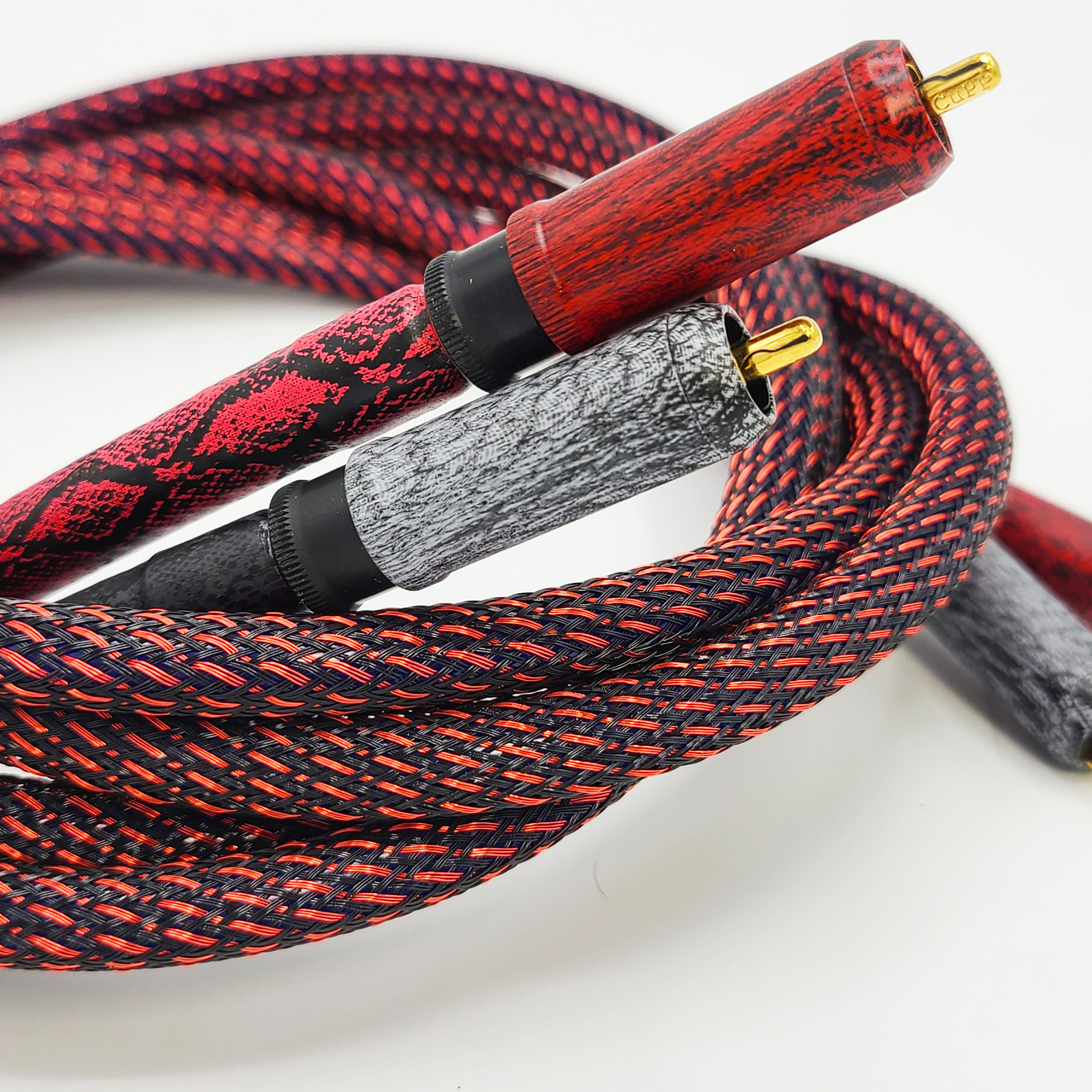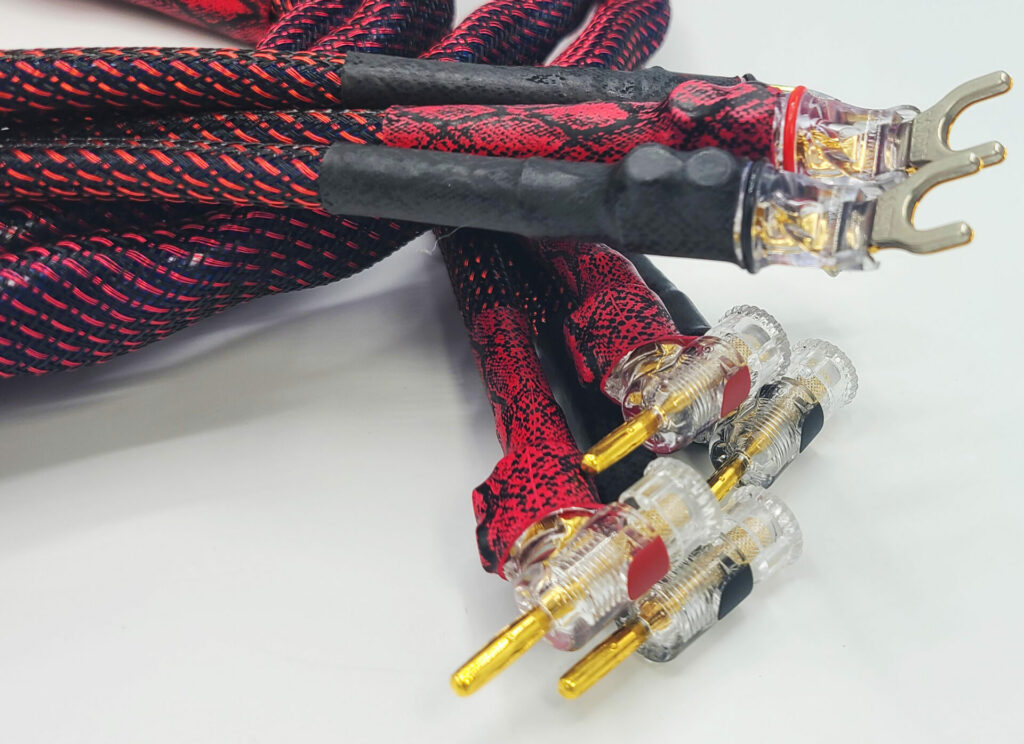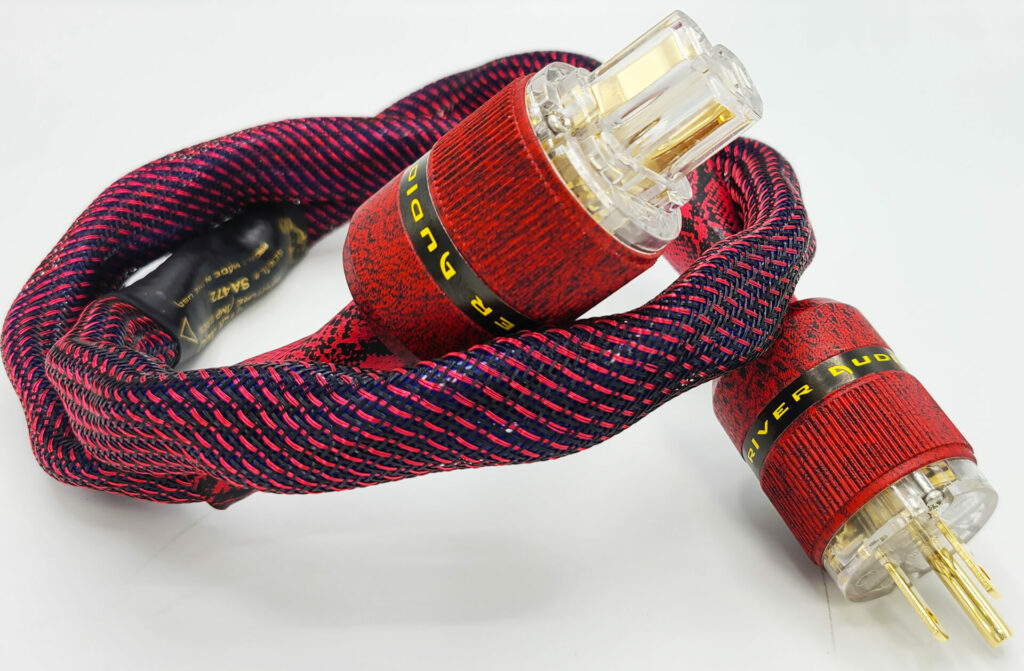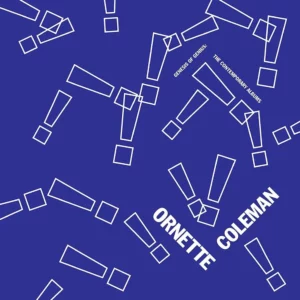
Good luck finding Riggins, Idaho, without a good map. Located in the west-central edge of the state in the Pacific Northwest, Riggins, an hour north of McCall, is just over a ridge where the Snake River courses through Hells Canyon. Beautiful, rugged country, but as unlikely a spot for a cable company as I can imagine. Nonetheless, that’s where you’ll find Snake River Audio and its affable founder/designer Jonny Wilson. And business is good.
Snake River Audio (SRA) designs and manufactures analog and digital cables across most categories, including power cords and guitar and pedal cables. Its business model is factory direct. The company prides itself on customer communication and service. Playfully or alarmingly (depending on your comfort level with these reptiles), each Snake River model is named for a particularly lethal species—jararaca, mamushi, cottonmouth, adder, boomslang. But clearly, it’s all in good slithery fun. Certainly, the scaly, snakeskin look of these cables will put a smile on your face. The brightly multi-patterned jacketing of each model casts a fluoro-iridescent glow conjuring up memories of 80s-era spandex-wrapped, glam-rocker gods like Van Halen’s David Lee Roth and/or Aerosmith’s Steven Tyler. While most cables attempt to disappear into a room’s décor (and usually not very effectively), Snake River models go the other way, seeming to celebrate their eye-popping outrageousness.
This review marks Snake River Audio’s debut in TAS. For the first evaluation, its premium Signature Series cables interconnects (RCA and XLR), speaker wire, and power cords got the nod. (When the term “premium” is tossed around in the cable world thoughts of mid-five-figure pricing often comes horrifyingly to mind. Not so with Snake River where most Signature Series models are below two grand.) SRA describes Signature as its “hybrid” conductor formulation. Its primary signal conductor is strands of 99.999% pure silver and red copper augmented with 24k gold. Optionally, Snake River goes the extra mile by making available models in pure silver or 24kt gold over copper, as well. Signature is configured in an innovative “Eddie Twist” of multiple twisted pairs and conformed in such a way that it yields greater signal surface area and reduced eddy-current distortions. Connectors are top-notch WBT-0681Cu (spades) or WBT-0610Cu (banana) connectors and Neutrik for the XLR interconnects. The dielectric material is either polyvinyl chloride (PVC) or Teflon, depending upon the model of cable. The outer sheathing is a metallic and nylon mixture.

Since I was running active speakers and required a longer run of interconnects, I was provided with SRA’s Mamushi interconnects—magnetically shielded versions of Signature Series cables specifically designed to reject noise due to RFI/EMI (a particular hazard for long runs of cable). SRA cables are cryogenically treated and cured for 200 hours before shipping.
Since SRA is a factory-direct operation, I found packaging and presentation to be superb, right down to the vacuum-sealed packets and the logo-inscribed carrying pouches. Jonny Wilson is particularly careful about service and customer relations. Once the order is submitted via the website, the customer receives regular emails informing him of the status of each cable as it moves through the various production and shipping processes.
I listened to the Snake River cables in two reference systems: my small-room compact system based on ATC SCM20 passive speakers driven by an Aesthetix Mimas integrated, and my full-range ATC SCM50 active system, which is augmented with a pair of REL S/812 subs, a dCS Bartók, and a Pass Labs XP-12 preamp. Signature Series power cords connected the Aesthetix Mimas integrated amplifier and the Lumin S1 media player or Parasound JC 3+ phonostage.
Despite its outgoing appearance, Snake River’s sonic performance ran far more than skin deep. Signature slipped into my system with all the élan and character of a high-end traditionalist. Clean, confident, and texturally colorful, Signature Series wires delivered music in a warm, relaxed, almost sedate manner. They settled into my system like a soothing balm. These cables didn’t glamorize the sound or make themselves the centers of attention; nor did they attempt—through selective frequency swings—to cure all manner of sonic ills that can beset an audio system. They evinced excellent balance across the criteria that my ears tend to key on, namely micro-dynamics, harmonic sustain, and top-to-bottom extension. Treble response was particularly smooth and easy on the ears—even trumpet blasts, though appropriately brassy and aggressive, still retained the instrument’s signature glow and bloom. Bass response was equally up to the task, portrayed with tuneful pitch and dynamic brio in a manner that equaled some of the best cables I’ve experienced.

A fluid and smooth signature was the first thing to draw my attention. As I listened to Vaughn Williams’ playful and colorful The Wasps Overture (LSO, Previn, RCA), what impressed me most was the continuity and flow through this score’s many musical moods, as it accelerates and then turns contemplative. The feeling of an unbroken stream of harmonic energy emanating from the orchestral soundstage had me concluding that Signature Series was a classical music lover’s dream.
Vocals, from chesty baritones to high-flying coloraturas, were expressive and detailed from the singer’s diaphragm up into the falsetto range. Sibilance possessed the requisite attack and transient electricity but rarely veered away from the naturalistic.
Dynamically, these cables could rock, unfazed by anything a typical, studio-pop recording could throw at them. They would, however, light up with musicality whenever a naturalistic, uncompressed recording came their way. Try Patricia Barber’s Higher twin-LP, 45rpm set on Impex for a master class in micro-dynamics, air, and harmonic sustain, coupled with the eerie sense of just being there in the studio with a group of world-class musicians.
Audiophiles often discuss the meaning of a lack of noise in a cable (or an entire system for that matter), citing the preternatural background silences that precede the opening note of a performance or the rests and lengthier pauses during a symphony. What these silences represent most to me is what isn’t being inflicted on the reproduced sound—what isn’t being transferred through the cables to produce distortions or colorations that can impair the music. Without a clean undistorted platform for the signal to spring from, everything that follows becomes, to a greater or lesser degree, colored or obscured. This is why timbre and textural expressiveness also rank high on my list of qualities that Signature conveyed—the darker sonorities of a viola versus the brighter bite of a violin or the warmer, gentler flugelhorn compared with the more aggressive trumpet. Signature Series effortlessly defined leading-edge information like a singer’s breath off a microphone, or the flick of a flat pick on a bluegrass mandolin, or a thumbnail riding the bottom strings of a flamenco guitar, or the grit of rosin on a cello bow.
Imaging was stable and consistent from straight-on centerstage into the periphery of the soundspace. Signature Series cabling held images in place like, well, a boa constrictor (ok, enough with the snake jokes). Even the lowest level orchestral voices (harp, for example), gentle background harmonies, and choral work were essentially free of veiling or opacity. SRA’s ability to soundstage and elicit three-dimensional space from broad acoustic spaces like the Troy Savings Bank (Laurel Masse Feather & Bone) or the Myerson Auditorium (Rutter’s Requiem) was very good, indeed.
Compared with pricier cables that have gotten my attention recently, like Audience frontRow or MIT Evo, Signature was only mildly subtractive, and then only in a couple of minor areas. For example, during Norah Jones’ “Nearness of You,” the piano soundboard wasn’t as broad and commanding as it is through the Audience frontRow. Vocal and low-level micro-dynamics could have been better graduated and the delicacy of the player’s touch on a piano keyboard reproduced in finer terms. And in a perfect world, I’d ask for a whiff more bloom and air on top. These are relatively minor issues that my ears tended to ignore after a minute or so of listening.
By any benchmark, Snake River Audio Signature cables represent an auspicious debut—the kind of coming-out party that would make anyone wonder what else might be cooking up in Riggins, Idaho. Combine that with competitive pricing, and these cables are well positioned for those seeking to make a major cable upgrade to their rigs. No snake oil here, folks, just the real thing.
Well worth seeking out, Snake River Audio cables embody authentic high-end audio values, dollar value, and performance that just never gets old.
Specs & Pricing
Price: Interconnect, $1695/1m RCA, $1795/XLR; loudspeaker, $2095/3m; power cord, $1545/2m
SNAKE RIVER AUDIO
1311 S. Main Street
Riggins, Idaho 83549
(208) 724-5152
snakeriveraudio.com

By Neil Gader
My love of music largely predates my enthusiasm for audio. I grew up Los Angeles in a house where music was constantly playing on the stereo (Altecs, if you’re interested). It ranged from my mom listening to hit Broadway musicals to my sister’s early Bob Dylan, Joan Baez, Beatles, and Stones LPs, and dad’s constant companions, Frank Sinatra and Tony Bennett. With the British Invasion, I immediately picked up a guitar and took piano lessons and have been playing ever since. Following graduation from UCLA I became a writing member of the Lehman Engel’s BMI Musical Theater Workshops in New York–working in advertising to pay the bills. I’ve co-written bunches of songs, some published, some recorded. In 1995 I co-produced an award-winning short fiction movie that did well on the international film-festival circuit. I was introduced to Harry Pearson in the early 70s by a mutual friend. At that time Harry was still working full-time for Long Island’s Newsday even as he was writing Issue 1 of TAS during his off hours. We struck up a decades-long friendship that ultimately turned into a writing gig that has proved both stimulating and rewarding. In terms of music reproduction, I find myself listening more than ever for the “little” things. Low-level resolving power, dynamic gradients, shadings, timbral color and contrasts. Listening to a lot of vocals and solo piano has always helped me recalibrate and nail down what I’m hearing. Tonal neutrality and presence are important to me but small deviations are not disqualifying. But I am quite sensitive to treble over-reach, and find dry, hyper-detailed systems intriguing but inauthentic compared with the concert-going experience. For me, true musicality conveys the cozy warmth of a room with a fireplace not the icy cold of an igloo. Currently I split my time between Santa Fe, New Mexico and Studio City, California with my wife Judi Dickerson, an acting, voice, and dialect coach, along with border collies Ivy and Alfie.
More articles from this editorRead Next From Review
See all
Oswalds Mill Audio K3 Turntable
- Apr 12, 2024

2023 Golden Ear: Schiit Freya S Preamplifier
- Apr 12, 2024




















